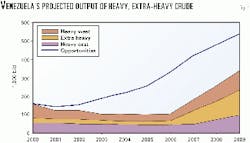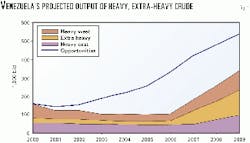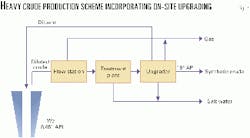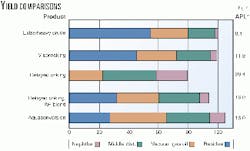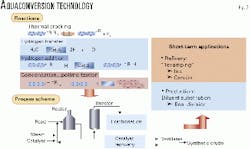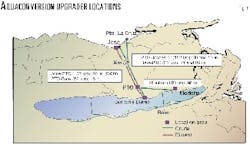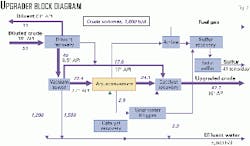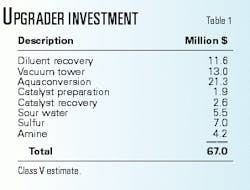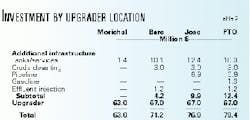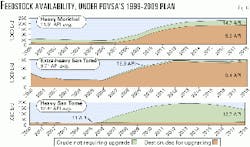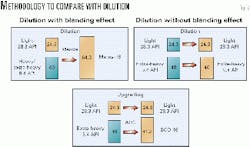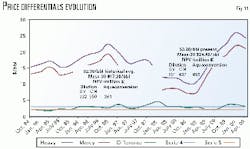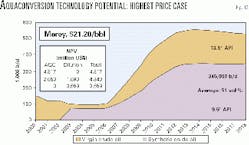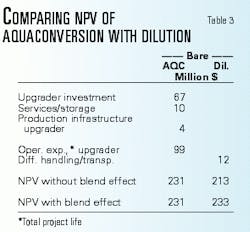The vast reserves of extra-heavy crude oil in eastern Venezuela are awaiting the introduction of lower-capital-cost technologies to make them available to the oil market.
At the present time, all the heavy oil commercialization in this region is done by dilution. PDVSA-Intevep has developed Aquaconversion, a catalytic steam conversion process able to upgrade this crude oil by transferring hydrogen from the water. Aquaconversion transforms an 8° gravity extra-heavy crude oil to synthetic crude oil of 16° gravity and decreased viscosity, at a rather low investment, thus leaving free for independent marketing the diluent (30° gravity crude oil).
This article summarizes the main results from a prefeasibility study to incorporate additional extra-heavy oil production in eastern Venezuela using Aquaconversion. Economics for the first 40,000 b/d Aquaconversion unit is compared with production by dilution, showing an increase of more than 10% in net present value (NPV). Aquaconversion offers the additional flexibility of coping with any shortcoming from a light crude exploration program, thus providing the strategic support to keep the overall production goals for the extra-heavy oil in place.
Background
Venezuela has extensive reserves of heavy and extra heavy crude oil in the eastern part of the country, including conventional production areas and the Orinoco Belt.
Of the conventional production areas, the San Tomé area has 2.3 billion bbl of proven reserves of heavy and extra-heavy crude. In the Morichal area, 77% of the 2.5 billion of proven reserves are extra-heavy crude with 9.5° gravity. At the present time, the Morichal area produces about 40,000 b/d, consisting of 32,000 b/d of Pilón crude with a gravity of 13° and 8,000 b/d of extra-heavy Morichal and Jobo crudes that are diluted to 13° gravity with Leona 21° gravity crude.
Production of these extra-heavy crudes with gravities of 7.5-10° is currently done by dilution in the well to be lifted to the surface, where it goes through a process scheme including degasification, dehydration, and desalting to be commercialized as a diluted crude of 13.5-16° gravity.
One of the main constraints in the production of extra-heavy crudes in eastern Venezuela is the availability of light or medium crudes to be used as diluent. PDVSA-Intevep parent Petroleos de Venezuela SA (PDVSA) has decided to incorporate more heavy and extra-heavy crudes in its crude portfolio to reach a total production capacity of 5.2 million b/d by 2009.
The heavy and extra-heavy crude oil potential contribution of traditional areas in the eastern part of the country to its total production is shown in Fig. 1.
The increase in heavy and extra-heavy oil production requires that, by 2006, there should be a steady increment in the production of these crudes, including the opportunity crudes that could be incorporated earlier and that could amount up to 500,000 b/d by 2009.
PDVSA's business plan for this period of time also considers the introduction of the Aquaconversion technology developed by PDVSA-Intevep to overcome the constraints imposed by the potential shortcoming of light crudes required as diluent.
Several scenarios of application of the Aquaconversion technology have been studied by PDVSA in order to define the first application of this novel technology, which opens the possibility of installing upgrading facilities integrated with surface facilities near producing wells (Fig. 2).
In this case, there are additional savings in transportation costs, because no diluent has to be used to transport the heavy crude up to the upgrader facilities planned near marine terminals on the coast.
This article summarizes the main results of these studies to incorporate the Aquaconversion technology into the production schemes of eastern Venezuela, including plant capacity, best location for the upgrader, and economics, as compared with the dilution option.
Aquaconversion technology
Aquaconversion is a technology developed by PDVSA-Intevep to convert residue and heavy or extra-heavy crude in the producing field into a transportable upgraded crude, eliminating the use of a light crude as diluent. The process is also utilized in petroleum refineries to increase conversion in existing visbreaking units without losing unconverted bottom-product stability.
Aquaconversion is a catalytic steam conversion process that is able to transfer hydrogen from water vapor into the unconverted bottoms of the crude, therefore increasing its stability by avoiding the formation of polycondensates that are coke precursors.
Fig. 3 summarizes the process fundamentals and process scheme, as well as the main applications that are foreseen for this technology in the short and medium term as an opportunity to add value within the PDVSA system.
The main reactions involved in the process start with the well-known thermal cracking mechanism to produce hydrocarbon-free radicals, followed by catalytic formation of hydrogen-free radicals, as well as hydrogen addition to the hydrocarbon-free radicals to avoid polycondensate compounds formation or polymerization reactions.1
The process scheme is rather similar to a conventional visbreaker using a coil furnace and a soaker reactor, plus product fractionation.
The main difference is that Aquaconversion requires the addition of a larger amount of water steam and the presence of the catalytic components that are added as homogeneous chemical additives, plus the catalyst recovery section consisting of a very well known physical operation widely used in refineries.2
Aquaconversion provides significant advantages compared with other thermal conversion processes, such as visbreaking and delayed coking, regarding product distribution and yields, as it is shown in Fig. 4 for the upgrading of an 8.4° gravity extra-heavy crude.
Visbreaking can improve the gravity up to 11.9° and with a lower total liquid yield than Aquaconversion, which is able to produce a 16° gravity upgraded crude with a much better product distribution.
Delayed coking, while able to produce a 28.4° gravity upgraded crude oil, has a significant yield loss due to coke and gas formation. The delayed-coking high-gravity product could be blended with the original 8.4° gravity crude to produce a 16° gravity upgraded crude oil, the same as Aquaconversion, but the total liquid yield will still be significantly less.
The Aquaconversion process development started in 1991 and went into pilot plant development, until the first commercial short-term test was performed at PDVSA's Isla refinery in an existing thermal cracker of 18,000 b/d capacity.
In 1997, a second short-term test was performed in the same commercial unit at the Isla refinery, but this time using residues from crude oils from eastern Venezuela.3
After these successful commercial short tests, the basic engineering for revamping the Isla refinery unit was performed in 1998 together with UOP LLC and Foster Wheeler, colicensors of the technology.
Engineering, procurement, and construction (EPC) of the Isla project was postponed in 1999 due to the shortage of heavy crude within the PDVSA system, which is being reactivated this year.
The current project status is that a new Class II cost estimate has been completed based on the new design basis that takes into consideration the heavy oil available for the Isla refinery. EPC was scheduled to start in January 2001 to have the unit ready for commercial operation in July 2002.
Another refinery application that is being considered is the integration of one of disincorporated visbreaking unit at CRP (Cardón), which is to be revamped into the Aquaconversion mode of operation. This project is currently in the conceptualization phase.
Regarding wellhead applications, conceptual engineering was performed in 1998 together with Foster Wheeler for a 100,000 b/d Aquaconversion unit in eastern Venezuela. However, after that conceptual design, important improvements in the process scheme have been introduced that were derived from a continuous development program performed by PDVSA-Intevep and UOP LLC in the last 2 years that has led to reduced capital and operating costs.
All of these improvements have been introduced in the revamp of the Isla refinery unit as well as in the visualization phase of the EP Oriente (Exploration and Production in the East of Venezuela) Aquaconversion application that has recently been completed after several studies that were performed in 1999 and this year. PDVSA has also started the visualization study for the application of Aquaconversion technology to produce 100,000 b/d of 16° gravity upgraded heavy crude in the Orinoco Belt.
This study is currently being performed by PDVSA-Faja, and it should lead to a "joint project execution" for the application of Aquaconversion in eastern Venezuela.
Applying Aquaconversion in E. Venezuela
Fig. 5 illustrates the concept of the application of the Aquaconversion technology as compared with the conventional dilution process to produce a 16° gravity Merey-type upgraded crude oil.
One special feature of Aqua con version is that it can be installed at any location between the wellhead and the cargo harbor for the 16° gravity crude, because no diluent is required to transport the upgraded Aquaconversion crude oil and, therefore, there could be significant savings in pipeline investment as compared with other upgraders that need to be located onshore, or with dilution that requires the supply of additional volumes of diluent.
Based on this extra flexibility provided by Aquaconversion and the projected portfolio of crude to be available in the different oil fields as well as the maximum use of existing facilities in the area, a location study was performed to decide the optimum site for the Aquaconversion upgrader.
Fig. 6 shows the four locations considered in the study and the pipeline systems associated with these potential sites.
At Morichal field, potential synergies were considered with existing facilities and equipment availability from the planned move of Bitor SA to Jose.
Bare at San Tomé and Patio de Tanques Oficina (PTO) were also studied to explore potential benefits from synergies with existing facilities. Jose was considered also as a potential location with and without synergies with Bitor. For the purpose of this study, an Aquaconversion upgrader of 40,000 b/d dry crude capacity was selected.
The main reasons to choose this capacity were the following:
- A volume of 40,000 b/d provides the highest investment efficiency, adding more value than a smaller unit and at the same time offers maximum flexibility for further modular growth.
- The amount of residue to be processed in the Aquaconversion core unit is 25,000 b/d, which represents a standard type of unit for existing commercial visbreakers.
- This capacity is quite similar to the size of the Isla refinery unit, where the process was demonstrated and the first commercial application is being built; therefore, the engineering design can be easily adapted with minimum modifications.
Aquaconversion upgrader
The overall block diagram for the 40,000 b/d Aquaconversion upgrader is shown in Fig. 7 for a case that a 51° gravity diluent is used, as in the existing Strategic Associations in the Orinoco Belt. If the Aquaconversion upgrader is located in the field, the diluent is a 32° gravity light crude similar to the Bitor production scheme.
The diluent recovery unit receives 51,000 b/d of desalted-dehydrated diluted crude to produce 40,000 b/d of 8.5° gravity dry crude and 11,000 b/d of diluent that is returned to the production well
The vacuum distillation tower operates at 130 mm of hydrogen to recover light and heavy vacuum gas oil to produce 22,400 b/d of 2.4° gravity short residue that is fed to the Aquaconversion unit. The catalyst preparation unit is equipped to receive the chemicals required to prepare the catalytic system, which are fed as a homogeneous liquid phase to an Aquaconversion unit consisting of a coil furnace, soaker reactor, and product fractionator.
The product leaving this conversion unit is a blend of the unconverted bottoms and the light distillate from the Aquaconversion unit, which yields 24,300 b/d of "Aquaoil blend" of 15° gravity crude that is mixed with the virgin vacuum distillates to be processed in the catalyst recovery unit to yield, in turn, 41,200 b/d of 16° gravity upgraded crude.
The auxiliary units include an amine plant to remove hydrogen sulfide from the conversion gases, sulfur recovery unit to produce metallic sulfur using a conventional Claus section and tail gas processing, and the sour water plant to recover the dissolved acidic gases from the process water by using a conventional stripping system. The acidic gas is sent to the sulfur recovery unit, and the water is reused in the catalyst recovery unit.
The preliminary estimated investment required for the 40,000 b/d Aquaconversion upgrader, within the battery limits shown in Fig. 7, is given in Table 1, and the total estimated investment required for the four locations considered in the study is shown in Table 2.
These figures include maximum utilization of all the potential synergy with existing facilities within the corresponding area.
According to the investment comparisons shown in Table 2, the best location is in the producing fields of Morichal and Bare due to significant savings derived from synthetic crude transportability, quality enhancement of crude segregated after blending the virgin crude with the synthetic crude and maximum reduction in diluent consumption.
Although Morichal requires the lowest investment, extra-heavy crude availability tends to favor Bare as the most attractive location.
Fig. 8 shows the heavy and extra-heavy crude availability in Morichal and San Tomé according to the crude portfolio approved by PDVSA at the end of 1999. This figure shows that, in order to provide the required type of feedstock that maximizes Aquaconversion added value, Bare (XH San Tomé) can provide 40,000 b/d of low-gravity crudes starting in 2003, while Morichal needs earlier incorporation of the opportunity crudes to meet the Aquaconversion design capacity.
Heavy crudes that are heavier than 9.5° gravity are amenable to add more value as processed in the upgrader, while lighter crudes are less economically favorable as Aquaconversion feedstocks.
Nevertheless, Morichal still represents the best location option once the crude portfolio is optimized, in order to take maximum advantage of the benefits of incorporating a new technology such as Aquaconversion.
An economic evaluation was done to compare Aquaconversion vs. conventional dilution as currently performed in eastern Venezuela. The basis for this economic study considered a 21-year project life period, with linear depreciation, 67.7% taxes, 16.67% government royalty fees, and 10% PDVSA legal contribution. Crudes and products were priced according to the prevailing PDVSA scenario at the end of 1999 (Regiones y Ambiente).
The upgrader was assumed to start operations in 2003, and no income due to diluted crude sales was considered during the 3 construction years. The diluent is a light crude (Mesa).
In order to avoid any blending effect that could influence the comparison with dilution due to price differentials between light and heavy crudes in the period of project life, an economic comparison was performed considering two methodologies, shown in Fig. 9.
In the case with blending effect, the total volume of Merey 16 is priced according to the value of the corresponding blend, while in the case without blending effect, the volume of extra-heavy crude and the light crude are priced separately based on the prices considered in the 1999-2009 PDVSA business plan.
In order to quantify the actual potential of the Aquaconversion technology to add value to the production business, the MAEP economic model was run to determine the optimum volume of crude to be produced that should be processed via Aquaconversion.
Results from this optimization are shown in Fig. 10, indicating that the maximum total net present value is obtained when 51% of the total production is done using Aquaconversion. The optimum is the result of selecting the most favorable feedstocks to Aquaconversion within the opportunity crudes framework.
In this way, Aquaconversion incorporates heavier crudes into the business plan portfolio that with dilution would not be economically attractive.
The economic analysis showed a significant sensitivity to price differentials between light and heavy crudes. To investigate such effect on the economic comparison, the MAEP model was run using the historical price differentials, as shown in Fig. 11.
Again, Aquaconversion proved to yield better cash flow income than dilution, being even more favorable at a higher price differential ($3.20/bbl) than at the historical price differential of $2.98/bbl.
To complete the sensitivity analysis, the crude portfolio optimization was performed using a higher price for the Merey 16° gravity, priced at $21.20/bbl, and the net present value difference between Aquaconversion and dilution yielded about $350 million for the optimum contribution of Aquaconversion to the monetizaton of the extra-heavy crude production (Fig. 12).
Dilution was compared with the Aquaconversion case using both methodologies, selling the same total volume as in the dilution cases but consisting of upgraded crude of 16° gravity plus the light crude oil that is not used to dilute extra-heavy crude oil.
The result of the comparison of the two methodologies is shown in Table 3 for the case of an upgrader located in Bare. Results indicates that Aquaconversion yields a higher net present value, about 10% over the best dilution case.
These results are quite favorable for Aquaconversion, because the cash flow produced by this technology is higher than using dilution and, at the same time, there is total freedom to produce extra-heavy oil without any restriction on light crude oil availability.
Nevertheless, the complete potential of the incorporation of this novel technology is not being fully accomplished within the restrictions imposed by PDVSA's crude portfolio.
Results
Aquaconversion as an upgrading technology is economically feasible for incorporating extra-heavy oil reserves of eastern Venezuela into the oil market and represents an option that is free of any dependency of light crude oil availability.
The introduction of this novel technology provides the additional flexibility required to meet the goal of PDVSA's business plan to reach 5.2 million b/d of total production capacity by 2009 without exclusively relying on light crude availability to be able to commercialize heavy crudes.
The application of Aquaconversion in eastern Venezuela opens new opportunities not being considered in a business plan based only on dilution, therefore promoting the growth of the eastern areas as well as in the Orinoco Belt.
This former business opportunity is being seriously pursued by PDVSA, and a feasibility study is being currently performed.
Acknowledgments
The authors want to express it sincerely appreciation to PDVSA for authorizing the publication of this article, as well as the contributions of Héctor Felizola, Luis Alfredo Velasco, and Luis Zacarías, all from PDVSA.
References
Marzin, R., Pereira P., Mcgrath, M., Feintuch, H., Houde, E., and Thompson, G., "The Aquaconversion process, a new approach to residue processing," NPRA annual meeting, Mar. 15-17, 1998, San Antonio.
Marzin, R., Pereira P., Mcgrath, M., Feintuch, H., Houde, E., and Thompson, G., "New residue process increases conversion, produces stable residue in Curacao refinery," OGJ, Nov. 2, 1998, pp. 79-86.
Pereira, P., Zacarias, L., Guitián, J., Solari, R.B., De Haseth, D., Houde, E., and Feintuch, H., "Petroleum Technology Quarterly," winter 1998-99, pp. 29-37.
The authors-
Pedro Pereira is a chemist with undergraduate and doctoral degrees from the University of Poitiers, France. He also undertook a 3-year, post-doctoral stay at the University of California at Berkeley. He has 19 years of experience in research and development of steam catalytic processes for a wide variety of hydrocarbons. Pereira has been the head of the Aquaconversion R&D project since 1991. At present, he specializes in chemistry within the refining and petrochemicals division of PDVSA-Intevep and is leader of the residue and heavy oils catalytic upgrading R&D group.
Cauri Flores has a degree in mechanical engineering from the Universidad Central de Venezuela (1982). At PDVSA-Intevep, he has worked in the energy optimization and heat transfer equipment design of the HDH project, Orimulsion manufacturing plant, and HHC preliminary furnace. He also worked on the revamp of the Jobo plant to the Aquaconversion process and in the commercial test of this technology. Flores participated in the conceptual engineering of the Prisma upgrader equipment design and technical supervision. He is Prisma project leader on surface facilities.
Hugo Zbinden has a degree in chemical engineering from the Metropolitan University, Caracas (1980). In 1991, he joined Intevep, in the process department, cost and planning section. Zbinden has wide experience in conceptual and detailed cost estimating and economic evaluation of oil and petrochemical projects. He currently is the cost estimating group leader in support of development of new technologies at PDVSA-Intevep such as HDH, Aquaconversion, and Orimulsion.
José Guitián holds a degree in chemical engineering from the Universidad Central de Venezuela (1979), as well as a masters in chemical engineering (1995) and a masters and PhD in mechanical engineering from the University of Minnesota (1996). He joined Intevep in 1979 as process engineer. Assigned in 1983 to the Ruhr Oel refinery operated by Veba Oil AG, Germany, Guitián worked in the development and commercial demonstration of the VCC and HDH technologies for the hydroconversion of heavy crudes. In 1989, he returned to Intevep as head of the hydrotreating section. In 1991, Guitián was the technology coordinator of the HDH project at PDVSA's refinery. He was named heavy crude upgrading program manager in 1992 and assigned to the University of Minnesota in 1993. In 1996, he returned to Intevep as project leader of basic research in heavy crudes. Since October 1997, Guitián has served in his current position of business leader in residues and heavy crudes. He is the author of 7 US patents and more than 20 papers.
Rodolfo Bruno Solari holds a BS in chemical engineering from the Universidad de Chile (1970) and a PhD in chemical engineering from the University of California at Davis (1974). In 1980, he joined PDVSA subsidiary Intevep SA, where he has successively worked as process development section head, refining process department manager, and heavy oil upgrading program manager.
Solari has been technology leader of heavy and extra-heavy oil activities, and he is part-time lecturer at Universidad de Simón Bolívar. He is specialist in heavy oil upgrading. In 1991, he received a UNESCO Science Award.
Howard Feintuch is manager of technology licensing at Foster Wheeler USA Corp., Clinton, NJ. He joined Foster Wheeler in 1964 as a process engineer and has served in various positions. Since 1982, Feintuch has been an adjunct professor of chemical engineering at Manhattan College in Riverdale, NY, where he teaches a graduate course in petroleum refinery engineering. He holds a BS and a PhD in chemical engineering from New York University.
Dan Gillis is the technology manager in the distillate and resid technologies group at UOP LLC responsible for marketing and sales of UOP black oil technologies. His responsibilities also include liaison with UOP's partners in black oil technologies and residue hydrotreating catalysts and managing the development and marketing of new residue conversion technologies. He has been involved in residue upgrading projects over most of his career and has a broad experience in all facets of residue upgrading, including operations, technology evaluations and development, project management, business development, and technology sales. After receiving his engineering degree in 1977 from the University of Saskatchewan, Gillis started his chemical process engineering career at the CCRL refinery in Canada then worked for Newgrade Energy and British Petroleum Co. PLC on oil sands and heavy oil projects. Prior to joining UOP in 1995, Dan was involved in process operations and project management for BP Oil and later Indian Refinery, both in the US.
